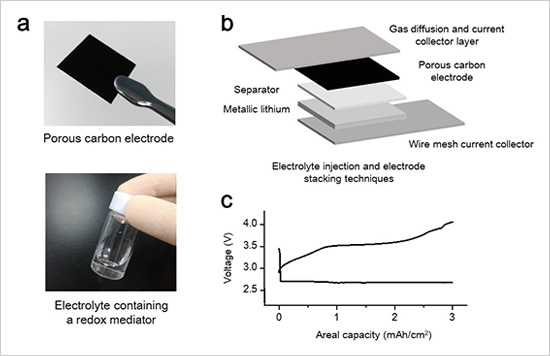
- Sustainable Planet -
- 3mins -
- 470 views
Battery breakthrough reaches energy density essential for electric planes
Researchers in Japan have developed a lithium-air battery with double the energy density of Tesla batteries.
lithium-air battery with an energy density over 500 wh/kg is one of the highest enter achieved
The National Institute for Materials Science, Japan (NIMS), and Softbank Corp. have developed a lithium-air battery with an energy density over 500Wh/kg — significantly higher than current lithium-ion batteries — and can be charged and discharged at room temperature. In addition, the team found that this battery shows the highest energy densities and best cycle life performances ever achieved. These results signify a major step toward the practical use of lithium-air batteries in applications such as electric aircraft.

Lithium-air battery achieves double the energy density of Tesla batteries
A lithium-air battery developed at the Japanese National Institute for Materials Science (NIMS), Japan, has an energy density of over 500Wh/kg. By comparison, lithium-ion batteries found in Tesla vehicles have an energy density of 260Wh/kg.
The new battery can also be charged and discharged at normal operating temperatures, making them practical for use in a wide range of technologies.
According to the researchers, the battery “shows the highest energy densities and best life cycle performance ever achieved” and marks a major step forward in realising the potential of this energy storage.
“Lithium-air batteries have the potential to be the ultimate rechargeable batteries: they are lightweight and high capacity, with theoretical energy densities several times that of currently available lithium ion batteries,” according to a release posted by NIMS.
The team is now planning to implement other materials into the battery with the aim of significantly increasing the battery’s cycle life.
Source: TheIndependent

The highest energy densities and best cycle life performances ever achieved
Lithium-air batteries have the potential to be the ultimate rechargeable batteries: they are lightweight and high capacity, with theoretical energy densities several times that of currently available lithium ion batteries. Because of these potential advantages, they may find use in a wide range of technologies, such as drones, electric vehicles and household electricity storage systems.
NIMS has been carrying out basic research on lithium-air batteries with support from the ALCA-SPRING program (ALCA: Advanced Low Carbon Technology Research and Development Program, SPRING: Specially Promoted Research for Innovative Next Generation Batteries). This program has been funded by the Japan Science and Technology Agency (JST) with the goal of accelerating large-capacity rechargeable battery R&D.
In 2018, NIMS and SoftBank co-founded the Advanced Technologies Development Center to conduct research with the goal of putting lithium-air batteries into practical use in mobile phone base stations, the Internet of Things (IoT), HAPS (high altitude platform stations) and other technologies.
Despite their very high theoretical energy densities, only a small number of lithium-air batteries with high energy densities have actually been fabricated and evaluated. This limited success is attributed to the fact that a large proportion by weight of lithium-air battery contains heavy inactive components (e.g., separators and electrolytes) that do not directly participate in actual battery reactions.
This research team had previously developed original battery materials that significantly increase the performance of lithium-air batteries in ALCA-SPRING-supported research. The team then developed a technique to fabricate high-energy-density lithium-air cells at the NIMS-SoftBank Advanced Technologies Development Center.
Finally, the team created a new lithium-air battery by combining these new materials and the fabrication techniques. The developed battery exhibited the energy density over 500 Wh/kg—substantially higher than currently lithium ion batteries. Notably, the repeated discharge and charge reaction proceeds at room temperature. The energy density and cycle life performance of this battery are among the highest ever achieved.*
* Based on surveys conducted by NIMS (as of December 14, 2021)
The team is currently developing higher-performance battery materials and plans to integrate them into the newly developed lithium-air battery with the aim of greatly increasing the battery’s cycle life. The team then plans to expedite efforts to put the battery into practical use at the NIMS-SoftBank Advanced Technologies Development Center.
Source: nims.go.jp

